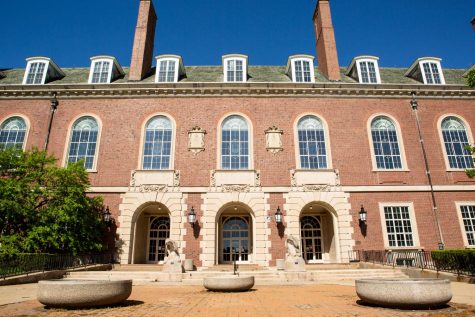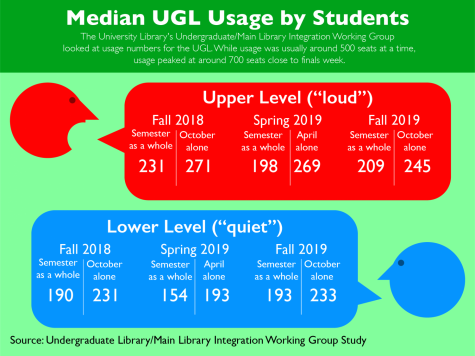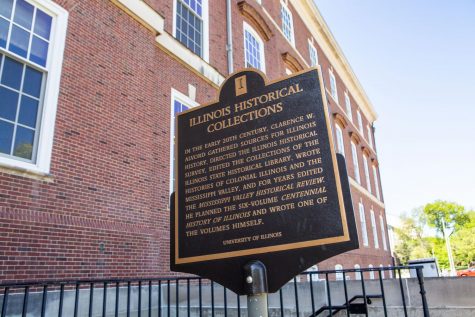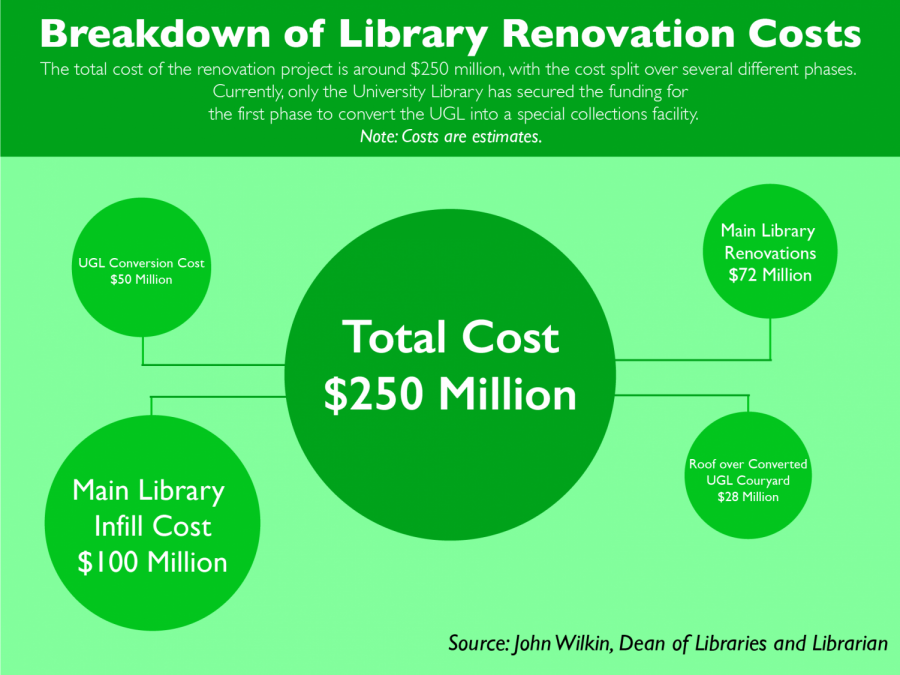UI library to undergo long overdue renovations
Undergraduate Library set to close January 2022 for conversion.
May 6, 2021
Sitting between the Armory and the largely subterranean Undergraduate Library is the Main Library.
Despite not being the most eye-catching building on campus, the historic Main Library, constructed in the 1920’s, housed one of the University’s most prized assets: its collections of rare books and manuscripts — one of the largest in the world.
Yet, the vault that houses the University’s Rare Book and Manuscript Library “is at the end of its useful life,” according to John Wilkin, dean of Libraries and University librarian.
It’s no secret that the Main Library is in need of renovation.
Problems with the Main Library’s bookstacks, such as issues with fire safety and the preservation of library materials, have been the subject of discussion among library staff for decades.
“Some folks may feel that the space in the Main Library is conducive to study or not conducive to study, but one fact remains — those stacks ranges are a danger to the collection,” Wilkin said. “They need to be replaced.”

Urbana, Illinois on Wednesday morning. The historic Main
Library is set to undergo much needed renovations. (Cameron Krasucki)
Since 2018, the University Library (the entity responsible for the various libraries on campus) has been working on a plan to renovate the Main Library and convert the Undergraduate Library into a dedicated facility for the University’s collection of rare books and manuscripts.
However, throughout the planning process, members of the humanities faculty and University Library administrators have been at odds over the renovation plans.
Concerns were raised by faculty regarding the location of UGL services during the years-long renovation period as well as potential flooding issues with the UGL.
Additionally, faculty members have expressed frustration at the University Library’s lack of transparency regarding the renovation plans, as well as what they see as half-hearted attempts at seeking input.
Attempting to address this, Ralph Mathisen, professor in LAS and newly-elected chair of the University Senate Library Committee, proposed a resolution in April to delay the UGL conversion and establish a committee to assess the needs of students, faculty and staff.
Despite being co-sponsored by 11 faculty senators and having the support of 14 University department heads, the resolution was rejected.
Problems with the Main Library
Despite their differences, both the University Library and the faculty members agree that the Main Library is long overdue for renovation.
“One of the things which everybody wanted and had been wanting for a very long time was to renovate the old stacks of the Main Library,” Mathisen said.
The conditions in the bookstacks of the Main Library pose a fire hazard and accelerate the decay of library materials, according to Wilkin.
“Susan Orlean’s book ‘The Library Book’ about the fire for the Los Angeles Public Library — the library burned down — the structure that she describes there is exactly the same structure we have for stacks ranges one through five,” Wilkin said. “It’s a fire hazard and environmentally it’s accelerating the decay of those materials.”
William Maher, University archivist and director of Archives for the University Library, noted that, due to the way the original stacks were built, fire can easily spread from one level of the stacks to another.
“If you go into the first section of the stacks, you can actually look down and drop a piece of paper from one level to the next,” Maher said. “And as a result of that, any fire that would start at one level, would present a risk of transmitting to other levels.”
Moreover, he noted that conditions of the older stacks of the Main Library are not conducive to preserve library materials from deterioration.
“If you’ve ever left a newspaper in your car for a week, especially in the summertime, by the time you go back to it’s yellow … that is because the paper contains wood pulp in it and when that interacts with atmospheric moisture and heat, it’ll start breaking down and acidify,” Maher said. “One of the best ways to globally stop that in its track is by storing material at lower temperatures and humidities.”
Specifically, Maher noted that stacks numbers one through three in the Main Library lack any air conditioning.
“It gets very hot in there over the years,” Maher said. “Even in the wintertime, because the heating systems were designed to essentially overheat, and the heating is exacerbating that problem.”
Also, mold was discovered near the rare books area of the Main Library in 2008. Although this was not in the stacks area of the Main Library, the discovery led the University to install a new heating, ventilation and air conditioning system in the Main Library, according to Maher.
Additionally, parts of the Main Library are not compliant with Americans with Disabilities Act requirements regarding accessibility, according to Lori Newcomb, professor in LAS and member of the Library Consultation Working Group. However, due to the age of the building, it was “grandfathered in.”
Renovation plans — a history
Get The Daily Illini in your inbox!
Since the early 1990’s, University officials have been considering different ways to go about renovations.
“As far back as the 1990’s, there have been plans underway or at least ideas about how to best renovate the Undergraduate and Main Library,” said Pia Hunter, former chair of the University Senate’s Library Committee and teaching assistant professor in Law. “That’s happened over a series of different meetings, and I think there was a big study in 2006 where planners came and assessed the structure.”
In 2006, the University Library hired several architectural firms to investigate the potential renovation of the Main Library with a focus on better integrating undergraduates into the Main Library.
The talk of renovations went quiet until 2008, when the University Library commissioned the now-defunct architectural firm Woollen, Molzan and Partners to draft a plan for the renovation of the Main Library.
This plan sought to address many of the issues with the Main Library and also construct additional stacks to the west of the building, but the almost $300 million price tag proved too expensive for the University, and so the plan was rejected.
In 2018, once Wilkin returned to the University Library after serving as an interim provost for the University, the University Library revisited the prospect of renovating the aging building, and the 2009 plan was “dusted off.”
However, parts of the 2009 plan were substantially altered.
The initial 2009 plan called for the construction of a new library facility near Newman Hall that would be serviced by robotics.
This new facility would be built before the demolition and infill of the Main Library stacks and would have served as replacement stacks during the construction period. However this was deemed too expensive and was dropped from the 2018 plan.
As a result, the order of construction had to be reversed. The University Library decided to convert the UGL first — before the Main Library infill and renovations would take place.
Under the renewed 2018 plan, the University Library will turn the UGL into a special collections facility and then demolish and rebuild the central stacks of the Main Library, using reclaimed space from the demolitions to host undergraduate services.
Although the University Library proposed a project schedule in March 2020, which estimated project completion by 2026, Wilkin said that this timetable “is no longer possible” and that rebuilding and renovating the Main Library “will be scheduled some time in the future.”
According to Wilkin, as it stands now, the University Library plans to first convert the UGL into a special collections facility, then demolish the old stacks of the Main Library and construct a new infill to it for undergraduate services, and then renovate other portions of the Main Library, before finally constructing a roof over the UGL courtyard.
However, much of when these stages will occur is dependent on whether and when the University Library will secure the funding to proceed.
While the University Library has secured around $46.8 million for the UGL conversion, around 90% of needed funding, they have yet to do so for the remaining stages, Wilkin noted.
According to him, the total cost of the renovation project is roughly $250 million spread over each stage of the project, with roughly $50 million for the UGL conversion, $100 million for the Main Library infill, $72 million for Main Library renovations and $28 million for constructing a roof over the courtyard of the converted UGL.
In its fiscal year 2022 budget proposal for the University Board of Trustees, the University included a request for $100 million in state funding for the Main Library infill portion of the renovation project.
However, that funding will not come in the 2022 fiscal year “because the Governor did not include the University’s request in his proposed budget,” Wilkin noted in a later email.
The University Library plans to fund the remaining stages (the Main Library renovations and the roof over the UGL courtyard) through a variety of sources, such as the University’s deferred maintenance fund and private donations, though this will be done over a longer period of time, he noted.
Nevertheless, Wilkin is confident that the University Library will secure the funds to complete the renovation project, even if it will take some time to do so.
The mounting concern
Among the various concerns regarding the renovation plan, the largest and most pressing concern is: What about the undergraduates?
When the UGL closes, the University Library will need to find a way to accommodate the undergraduate patrons who previously used the UGL.
To plan for this, the University Library established the Undergraduate/Main Library Integration Working Group to investigate options for the relocation of undergraduate services and to find alternative spaces for use by undergraduates during the renovation period.
Their solution was to find space in other University libraries and relocate undergraduate services there.
“(The working group) has identified the need for between 535 and 700 seats based on use of the UGL,” Wilkin said. “And they’ve identified between 818 and 878 additional seats in the Main Library, ACES, Grainger and the Music and Performing Arts Library to meet those needs without displacing other users.”

Faculty members take issue with this plan, noting that undergraduates and other library patrons would have to endure this crowding for several years until the Main Library infill is complete.
“There’s going to be a couple of rooms that are repurposed for undergraduate study space, but whatever that is, it’s going to be a shadow of the UGL,” said James Brennan, professor in LAS and a member of the University Senate Library Committee. “And that’s going to be true for a minimum of five years, maybe ten years.”
Brennan, who attended the University as an undergraduate in the 1990’s, noted that the UGL was designed as a study space and is now being repurposed for a task it wasn’t designed for.
“The Undergraduate Library is designed as a study space, that’s why it’s so good,” he said. “It’s designed for light. Now we’re repurposing it as a structure where light can’t go in.”
Newcomb noted that the plan would leave fewer library spaces near the Main Quad for undergraduate use.
“I don’t think that plan is in the best interest of the undergrads,” she said. “That there’s going to be no group study space within walking distance of the Main Quad or the southwest residential campus, is really a shame.”
Newcomb also noted that the atmosphere would be different than in the UGL and the alternate spaces would be more crowded as more students would be sharing the same space.
“No matter what they say about (the) number of seats, the loss of square footage for human use is MASSIVE,” Newcomb later stated in an email.
Flooding issues
Moreover, there has been concern over potential flooding issues with the UGL.
“The Undergraduate Library had been built on a swamp with known drainage issues,” Mathisen said.
When it was initially constructed in the 1960’s, the UGL was installed with two sump pumps and a backup generator for redundancy. Even if one pump fails during a power outage, the remaining sump pump and the backup generator would be able to protect the UGL from flooding.
However, to ensure this redundancy remains viable, the pumping equipment needs to be consistently maintained, and it is difficult to tell whether the sump pumps remain functional unless they are in use — when they are needed to pump water out.
In 2017, there was an instance where both pumps failed, resulting in water reaching the floor of the UGL’s equipment room, roughly two feet below the sub basement.
Although the pumps were previously identified as being beyond their serviceable life, they were not replaced immediately.

While the water issue is not their largest concern, many faculty and staff are uncomfortable with the prospect of storing the University’s rare and archival collections in the UGL, given the potential risk of flooding.
“If you were going to continue to use the UGL the way it has been, and the worst happens and the water table rises or there’s flooding that the equipment can’t take care of, then it’s damaged … and the books that would be there would be damaged or destroyed, or cost a lot to clean,” said a source familiar with the topic. “But that’s different than when you’re putting rare and unique collections there … That Issac Newton manuscript that they’ve got? There’s no other one in the world. None.”
Lack of transparency
Most of all, faculty members take issue with what they see as a lack of transparency, and feel that the University Library is not taking outside input seriously.
“Our frustration has been that the library administration is completely uninterested in even speaking for five seconds about any alternatives,” Brennan said. “They say ‘This is the only alternative; it’s the only one that’s financially viable; if we don’t move ahead right now, not only will we lose money but these endangered materials will become further endangered.’ And that’s kind of been the standoff point for probably two years now.”
He further noted that the faculty members feel that they have been listened to, but not heard.
“There’s been a lot of consultation, but there’s been no real listening,” Brennan said. “Particularly to the idea that we need to consider alternatives, and if the alternatives look really bad by comparison, then maybe there would have been a pretty wide consensus to go ahead with this plan. But there hasn’t been that discussion.”
Newcomb takes issue with the University Library’s lack of communication with the public regarding the impacts the UGL conversion will have on students.
“My objection is that the changed priority hasn’t been communicated to the public so that the undergraduates realize how long they’re going to be homeless,” she said.
This view is echoed by Brennan, who wonders if undergraduates are “even aware that the Undergraduate Library is gone.”
“I think it’s increasingly clear the costs, particularly regarding student displacement from study space,” he said. “That’s clear now, but that was never clear during the whole consultation process.”
Brennan also noted that this lack of communication has allowed the University Library to remain tight-lipped about many of the renovation plan’s details, particularly regarding the cost of the plan.
“You have people right now who are in junior high school, who won’t have the same sort of study space and experience that people who were students here until March (2020) had,” Brennan said. “That’s a huge cost. I don’t know what figure you could put on that, but … if undergraduates understood the public-space cost that this plan has, they might ask for more figures about why this is deemed the only acceptable plan.”
Mathisen said that the University Library has refused to consider any outside input when planning the renovations, noting further that any attempt at dialogue through a series of “town halls” was “heavily stage-managed” by the University Library.
As a result, he proposed a resolution to the University Senate for the creation of a committee to review the renovation plan and delay the UGL conversion by six months.
Ultimately, the resolution was rejected by the University Senate even though it was broadly supported by the humanities faculty after the University Library came out in heavy opposition to it, noting that the delay would put the funding for the UGL conversion at risk.
Since then, Mathisen has proposed a resolution in the LAS faculty senate calling for the college of LAS to create an independent ad hoc committee “to continue dialogue with the library administration and advocate for the interests of our undergraduates during the renovation.”
Despite this, the University Library maintains that student and faculty interests were always represented during the planning process for renovations.
Wilkin pointed out that the Library Consultation Working Group, which was created by the provost to discuss the renovations, was largely composed of faculty as well as an undergraduate and a graduate student.
Additionally, he noted that the University Library held several town halls where the University Library presented its renovation plan and answered questions about it.
Sara Holder and David Ward, co-chairs of the Undergraduate/Main Library Integration Working Group noted that they consulted with different “focus groups” of students when developing their plan for undergraduate services.
Moving forward
The UGL will remain open next fall, though it is set to close in January 2022, when the building will be vacated, with estimated due date of 2024 for the conversion.
Beyond that however, there is no timetable set in stone for the other stages of the renovation project.
Wilkin could not provide an exact time for when construction on the Main Library infill will begin, only that he “can say for sure that they wouldn’t start until after 2024” when the UGL conversion is complete.
“We have some of the most extraordinary rare and archival collections in the world, and we’re going to create a home for them,” Wilkin said.






